Moving my boat and trailer around my backyard has been a dreaded chore and, at times, an injury-causing one. My Welsford Pathfinder with motor, sails, anchor, and other gear, weighs about 485 lbs, and add to that about 700 lbs for its aluminum trailer. My yard is no putting green with its clumpy grass, random divots, and hidden debris which all impede progress. It’s really a two-person job, but I am usually alone in getting the boat across the lawn to the driveway. As I move through my late 50s, the task grows more challenging.
For many years, I relied on a cheap 12-volt winch, combined with a two-wheeled trailer dolly. This worked okay but it was a hassle to haul out the winch, the deep-cycle battery, and the dolly before dragging out the cable, adding some chain or rope, and finding an attachment point. When the winch failed this past year, I was ready for an upgrade.
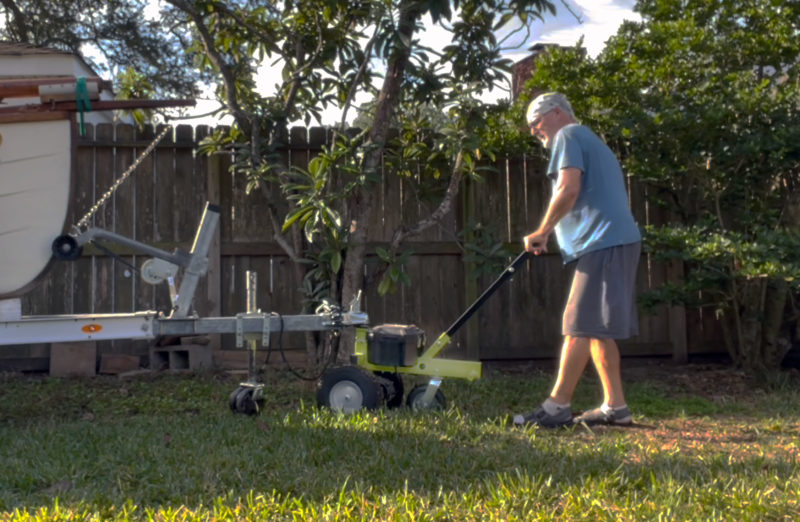 Photographs by the author
Photographs by the authorFlat and even ground is ideal when using the Tow Tuff but there can be few yards that meet those criteria. The author’s Tow Tuff handled the bumps and lumps of the lawn, as well as a 3-degree ramp up and over a 6″-high deck. Thus, he was able to move his Welsford Pathfinder singlehanded and with energy to spare.
I ordered the 24-volt Tow Tuff TMD-3500ETD Electric Trailer Dolly from Northern Tool & Equipment, and it arrived at the store nearest me a few weeks later. The 110-lb box fit easily in the back of my Subaru Outback. I’ve assembled a lifetime’s worth of furniture and assorted other stuff, so the assembly was straightforward for me and took less than 30 minutes. It required not much more than attaching the wheels and handlebar and threading some wires through the metal tubing.
The dolly is powered by two sealed 7 AH 12-volt batteries. It can travel up to 1.5 mph with variable speed in forward and reverse and has a capacity of 3,500 lbs with a 600-lb tongue capacity. The dolly is intended for relatively flat and even ground. The 13″ main tires need traction, so they may not move a heavy trailer over loose gravel, wet grass, or slick pavement. It comes with a 2″ ball, which can be swapped out for a different size. The ball height is adjustable from 22″ to 28″.
The dolly can move up inclines of up to 4 degrees, according to the owner’s manual. Plan ahead: the Tow Tuff, like manual two-wheeled dollies, has no braking mechanism (although backing off the throttle adds some resistance to the drive wheels). If the trailer starts rolling down the driveway, it’s going to be difficult, if not impossible, to stop it unless you have a helper with wheel chocks standing by or can rig up a system that you can deploy by yourself (I picture a board that you drag in front of the tires via rope that you can strategically drop).
The route from my trailer’s parking spot in the grass to the concrete driveway includes riding up and over a 6″-high deck via a wooden ramp. This obstacle was my biggest concern: would the dolly have enough torque to pull or push the trailer up the ramp? Would the tires have enough traction? That test was the first one I tried, and the power dolly handled it with ease. I measured the ramp with a digital angle gauge, which indicated a 3-degree incline, well within the specified 4-degree parameter.
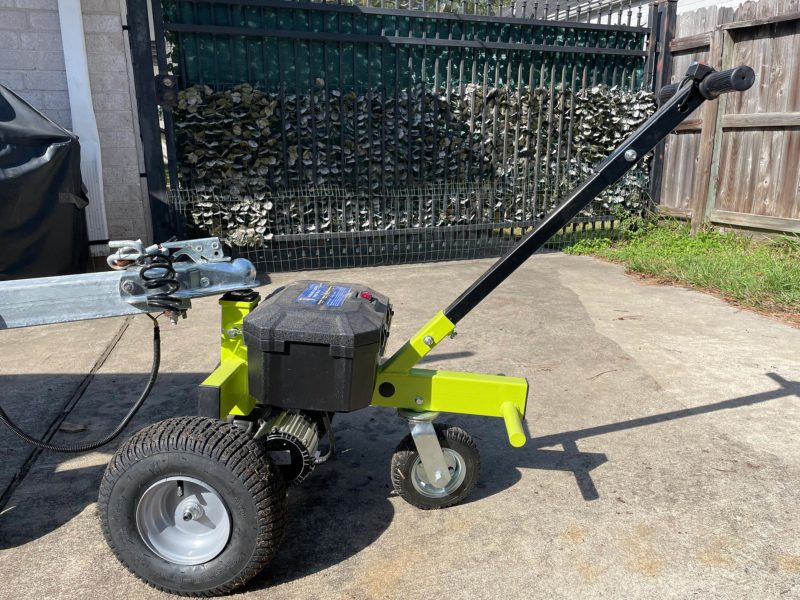
The Tow Tuff comes with a 2″ ball as standard, but this can be swapped out to suit a smaller or larger trailer hitch. The welded bar beneath the dolly handle allows the operator to use their own bodyweight to bring more traction to the tires and to keep the swivel caster in contact with the ground.
The Tuff Tow has three wheels: two 13″ pneumatic tires attached to the drive train, and a swiveling 8″ caster. When pushing the trailer, the torque on the tires pushes the tongue weight down onto the caster. However, pulling the trailer sends the torque and tongue weight in the other direction, where there is no caster. The result is, anytime you encounter additional resistance, the dolly handle wants to pull up and out of your hands. The heavier the load, the more pronounced this is. To help manage this force, and to add more weight/traction to the larger tires, there is a bar welded on the dolly frame that you can step on.
The variable-speed thumb throttle on the right handle is convenient to use and responds quickly, controlling movement up to 1.5 mph, an easy walking speed. There is no jerking or lurching even when the dolly is full throttle. Forward and reverse are selected via a rocker switch on the left handle. The throttle also has an LED gauge to indicate remaining battery life.
My experience with the electric dolly has been fantastic, especially when compared to my previous system. I was a little surprised that the dolly had trouble managing a small lip: I park the trailer tires on top of some thin paver stones to keep them off the wet ground. It’s only a 3⁄4″ lip, but it brought the tires to a stop. I was able to overcome this by backing up the dolly several feet and giving it a run at it with full throttle. I have learned how to maneuver the Tow Tuff to easily align it exactly where I want.
Do some research before dropping $1,000 or more on this convenience. You will find plenty of negative reviews, most of which appear to result from high expectations for moving trailers weighing much more than mine and using it on questionable surface conditions. From my perspective, the electric dolly works well and is much cheaper than multiple trips to the chiropractor followed by three days of Icy Hot, immobilized on the couch. Been there, done that.![]()
Mike Olson lives in Houston where he retired as a marketing communications writer in the financial industry. He sails his Pathfinder, CRUCIBLE, on the Texas Gulf Coast and inland lakes.
The author’s Tow Tuff TMD-3500ETD was purchased through Northern Tool, but Target, Walmart, Amazon, Tractor Supply, and other retailers also list it on their websites. The Tow Tuff is not likely to be stocked at a brick-and-mortar store. The dolly has a one-year limited manufacturers’ warranty on parts. A reputable retailer might make things easier should you decide to return it.
Is there a product that might be useful for boatbuilding, cruising, or shore-side camping that you’d like us to review? Please email your suggestions.






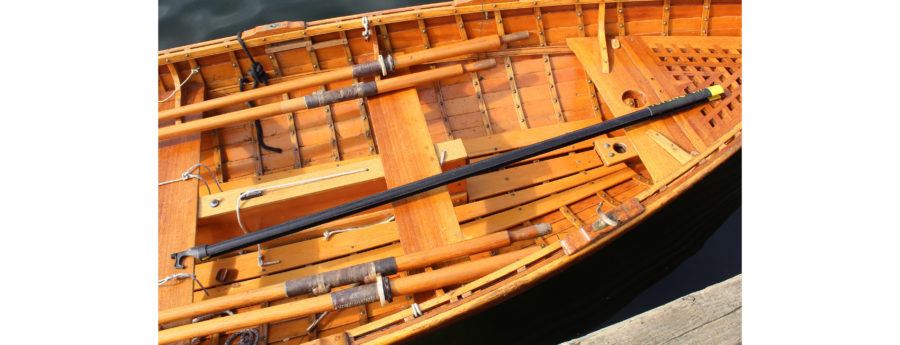

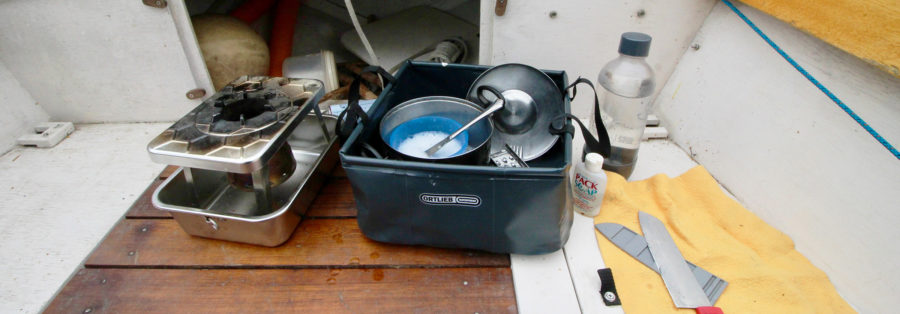

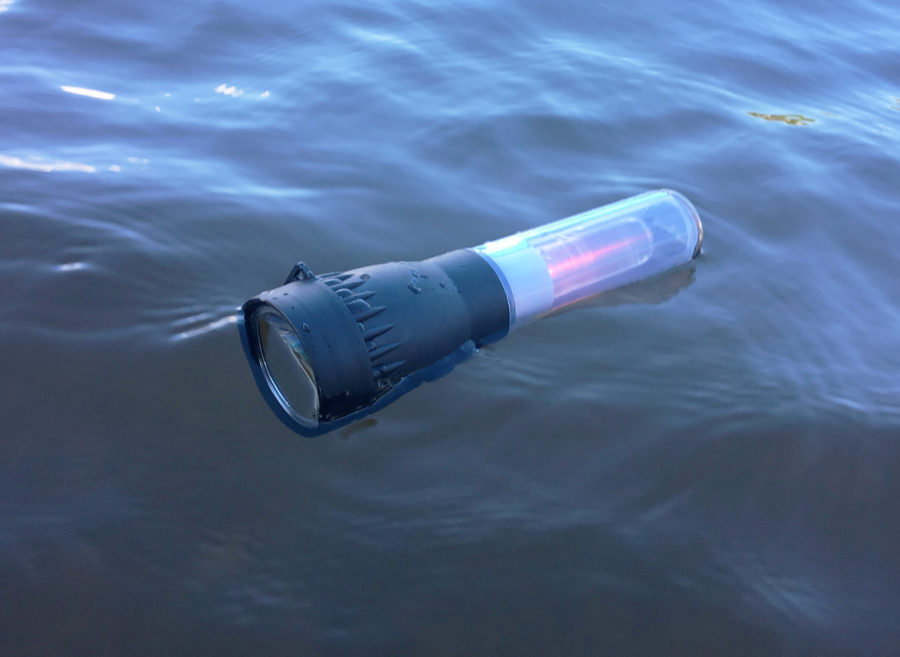

Nice solution. I have a small tractor I use to move my boat trailer and camping trailer. My yard is very rough due to the damage done by moles, and the tractor maneuvers the rough course quite nicely.
The powered trailer dolly looks like a grand solution for smaller trailers and smoother ground. Thanks for the review.
Cheers
I added a hitch to my riding mower for about $40, but if I didn’t already have the mower, something like this be excellent. Thanks for the pointer!
I once borrowed a riding mower from a friend and tried moving the boat around. The big mower was awkward in my smallish backyard.